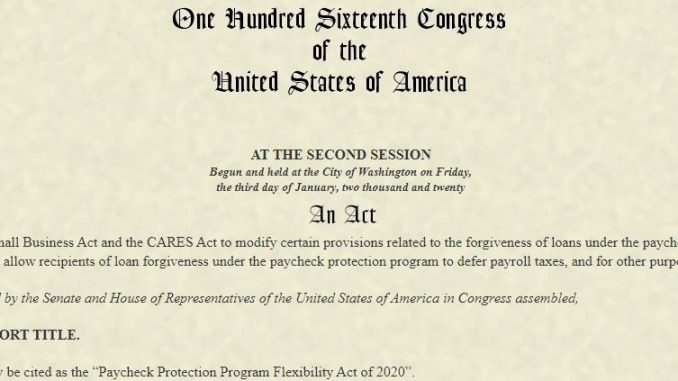
On June 5th the President signed the Paycheck Protection Program Flexibility Act of 2020 (PPPFA).
Why was this needed? Because with delayed guidance, imperfect roll-outs, delays in funds being received and an increasingly burdened small business community, Congress recognized the very program designed to aid small business was about to endanger small business.
There will be no PPP loan applications accepted after June 30, 2020.
Here is a quick list of changes to PPP:
- There is a new PPP application.
- Updated PPP Loan Forgiveness Application
- Newly applying small businesses will have the covered period extended to begin on the date of the origination of the covered loan and end 24 weeks later or Dec. 31, 2020 whichever comes first.
- If you already have a PPP loan, then you can choose to keep the original 8-week period or switch to the 24-week period.
- If you are unable to meet the employee/payroll requirements because employees are unable or unwilling to come back to work, then documentation is required in order to preserve the forgiveness aspect of the loan. You may also be able to maintain forgiveness if you are unable to find qualified workers for the positions offered. Once again, make sure to document these efforts.
- Some businesses may find their overall ability to get back up to pre-Covid-19 levels is difficult due to compliance with government requirements or CDC guidance. In order to preserve the forgiveness aspect of the PPP loan make sure to document the regulations, guidance, and rules limiting your ability to become fully operational.
- The original PPP loan required at least 75% of the funds be used toward payroll and benefits costs. In the PPP Flexibility Act that has been changed to at least 60%. The remaining 40% may be used to pay interest on a mortgage (not principal), rent, or a covered utility.
- The total time to repay the loan has been extended to 5 years.
- Businesses who took a PPP loan may be able to delay paying payroll taxes.
- There are changes to the payment deferral period as well. For those applying for forgiveness, it has been changed from 6-months after the end of the covered period to the date on which the amount of forgiveness determined under section 1106 of the CARES Act is remitted to the lender.
- For those who are eligible to apply for PPP forgiveness, but do not apply, those loan payments will begin on the day that is not earlier than the date that is 10 months after the last day of such covered period.
and a PPP EZ Loan Forgiveness application.
There is a significant amount of documentation required both for forgiveness and for tax purposes. Marcum Tax Accountants and Advisors hosted a webinar on June 12th with lots of information and the changes highlighted in red for easy reference.
IRS Notice 2020-32 describes the taxability of PPP funds.
...Specifically, this notice clarifies that no deduction is allowed under the Internal Revenue Code (Code) for an expense that is otherwise deductible if the payment of the expense results in forgiveness of a covered loan pursuant to section 1106(b) of the Coronavirus Aid, Relief, and Economic Security Act (CARES Act), Public Law 116-136, 134 Stat. 281, 286-93 (March 27, 2020) and the income associated with the forgiveness is excluded from gross income for purposes of the Code pursuant to section 1106(i) of the CARES Act…
Secretary Mnuchin’s announcement on June 8th highlighted some of the new elements, but we are still waiting for more guidance from Treasury, so watch for that guidance and consult with your CPA or Attorney.
As we continue down the road of uncertainty, new rules, and conflicts between legislation passed into law and agency interpretation, I can’t help but wonder… Do we even remember when stabilizing small business was a concern and not a tragedy? That date would be March 17th, the day before the Families First Act was signed into law.
The Families First Act pushed down the FMLA requirements to all business, including business with 50 or fewer employees. Between March 18 and March 31st there was a torrent of small businesses realizing they could not comply with FMLA and so the layoffs began.
Perhaps a simpler way to correct this error is to simply go back to the original FMLA law?
Here is a list of resources you may find helpful:
NAR PPP vs. EIDL Loan comparison updated June 11, 2020
NAR SBA Cares Act FAQs
NAR PPP V EIDL infographic
NAR Main Street Lending Program FAQ
NAR Coronavirus Guide for REALTORS®
NAR Library & Archives – Corona Virus Section
Forbes
National Law Review
National Law Review – Taxes
Journal of Accountancy
U.S. Chamber of Commerce Guide Independent Contractor Guide
